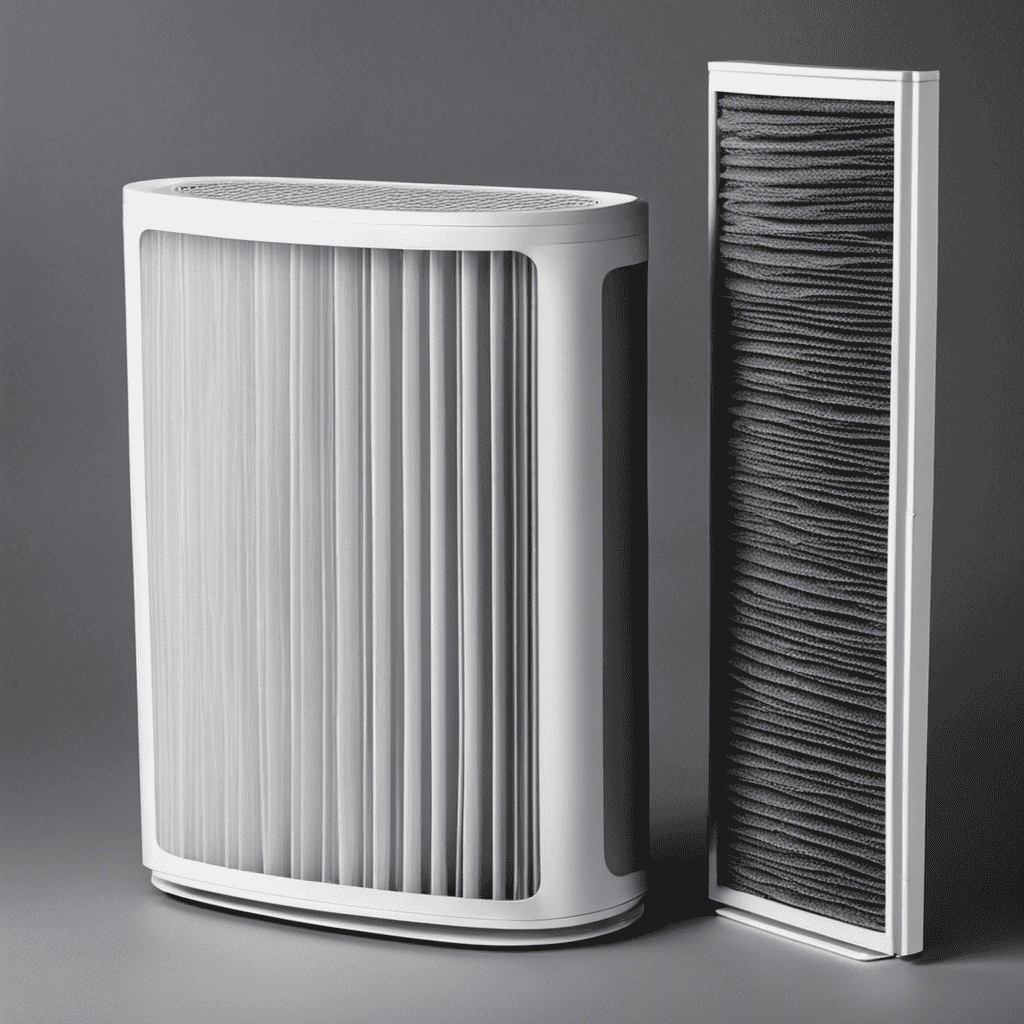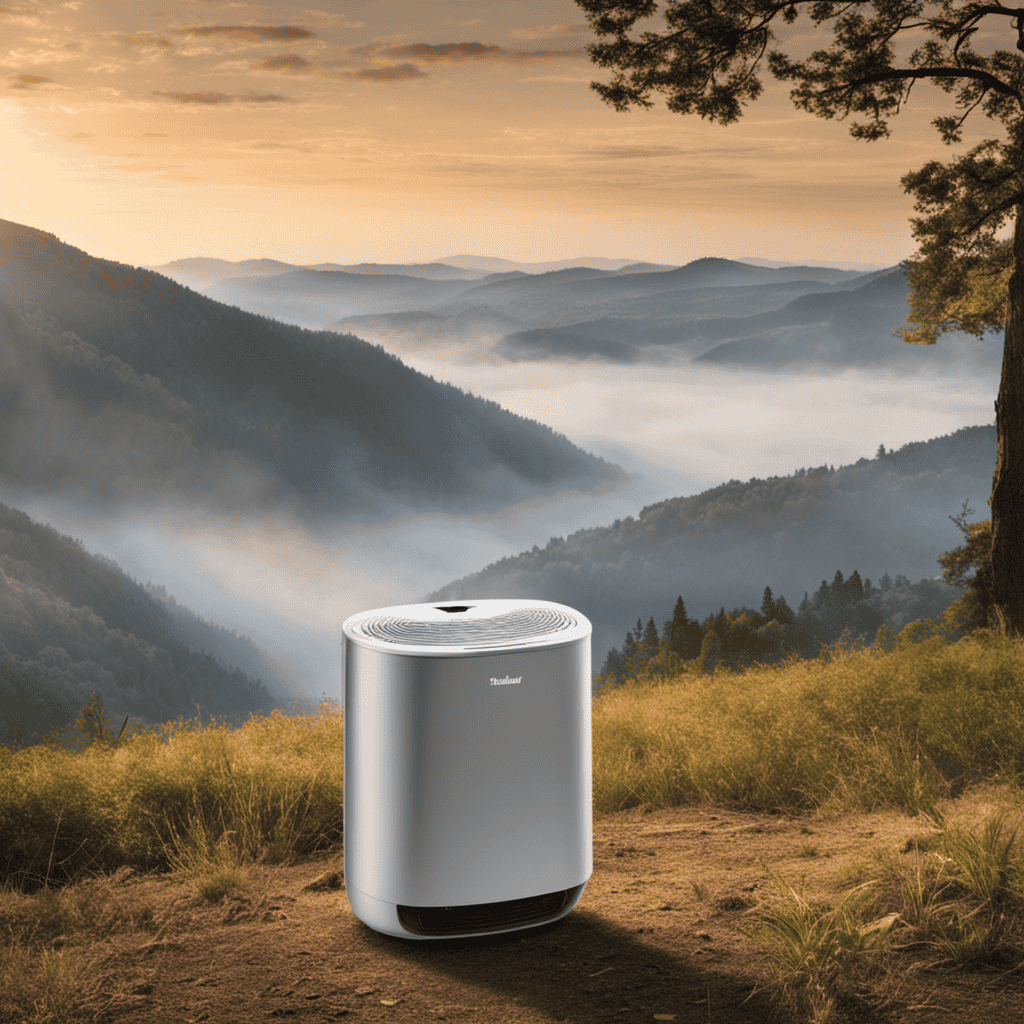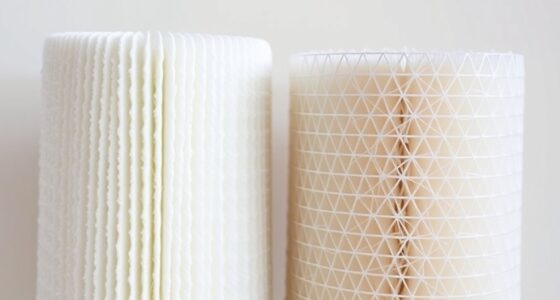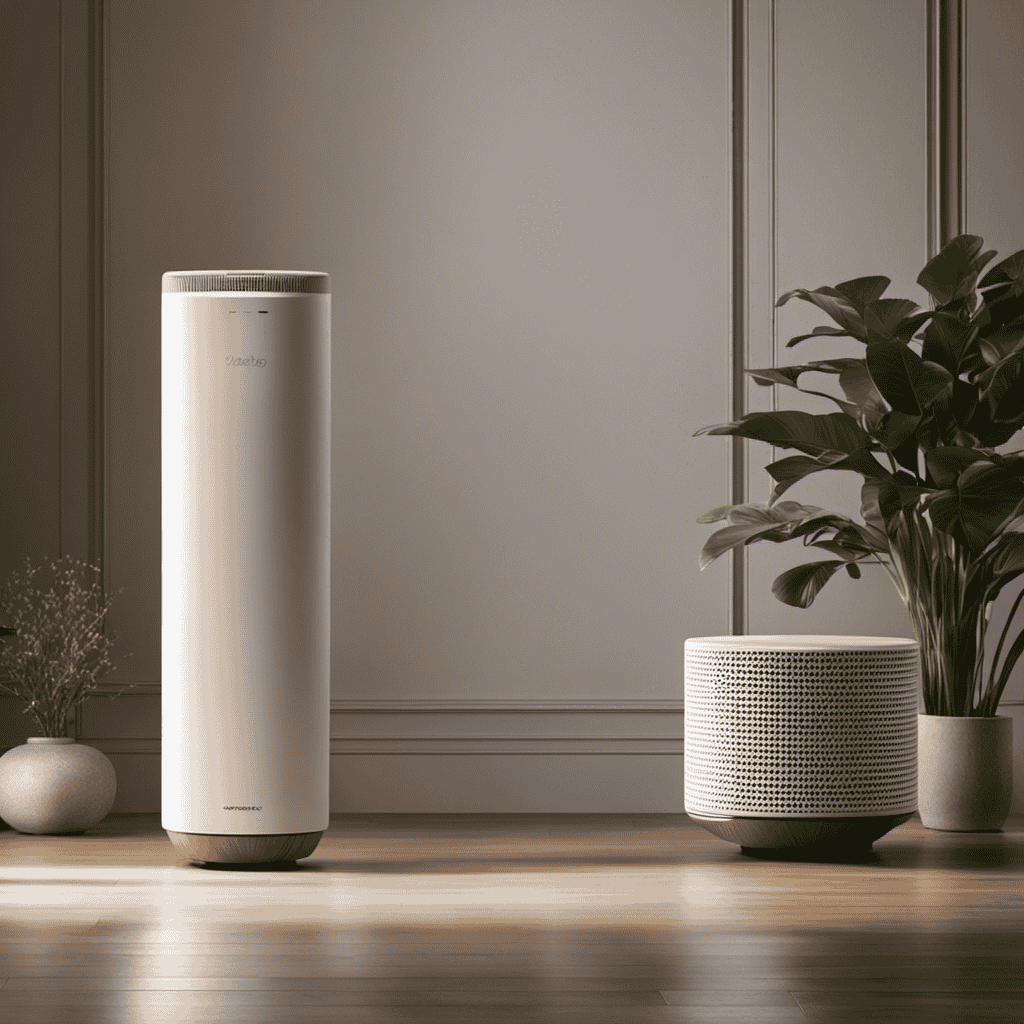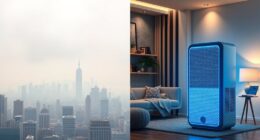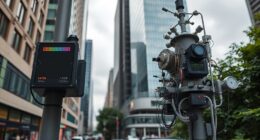As a fan of air purification, I am amazed by the effectiveness of these devices in improving the air quality of our indoor spaces.
But have you ever wondered how often to change those crucial air purifier filters?
Join me on this informative journey where we’ll delve into the factors that influence filter lifespan, the impact of filter maintenance on efficiency, and even budgeting for this essential upkeep.
So, sit back, relax, and let’s breathe in the knowledge on how often you should change your air purifier filters.
Key Takeaways
- The type of filter and air quality in your home are key factors that determine the lifespan and efficiency of air purifier filters.
- Following manufacturer’s recommendations and guidelines for filter replacement ensures optimal air purifier function and clean air.
- Regular monitoring of air quality and real-time data on pollutant levels can help determine when to replace air purifier filters.
- Factors such as pollution levels, presence of pets or smokers, and living in high pollutant areas may require more frequent filter replacement.
Factors to Consider
When deciding how often to change air purifier filters, there are several factors to consider.
Proper air purifier maintenance is essential for ensuring clean and healthy air in your home. One of the key factors to consider is the filter replacement frequency. The frequency at which you should change your air purifier filters depends on various factors such as the type of filter, the air quality in your home, and the manufacturer’s recommendations.
The type of filter you have plays a significant role in determining how often it needs to be replaced. Different filters have different lifespans and efficiency levels. For example, HEPA filters are known for their high efficiency in capturing small particles, but they may need to be replaced more frequently compared to other types of filters.
The air quality in your home is another important factor to consider. If you live in an area with high levels of pollution or if you have pets or smokers in your home, your filters may get clogged more quickly, requiring more frequent replacements.
Lastly, it is crucial to follow the manufacturer’s recommendations for filter replacement frequency. They have the expertise and knowledge about their specific products and can provide you with the most accurate advice.
Considering these factors will help you determine how often you should change your air purifier filters, ensuring that your air purifier functions optimally and provides you with clean and healthy air.
Air Quality Standards
Air quality standards dictate the recommended frequency for replacing air purifier filters. It is important to follow these standards to ensure that your air purifier is functioning optimally and providing you with clean and healthy air.
Here are some key points to consider regarding air quality standards:
-
Regular replacement of air purifier filters is necessary to maintain the effectiveness of the purifier. Over time, filters become clogged with pollutants and allergens, reducing their ability to capture and remove harmful particles from the air.
-
The frequency of filter replacement varies depending on several factors, including the type of air purifier, the level of air pollution in your area, and the number of people living in your home. It is recommended to consult the manufacturer’s guidelines or seek advice from a professional to determine the ideal replacement schedule.
-
Air quality monitoring is essential in determining when to replace air purifier filters. There are devices available that can measure the air quality in your home and provide real-time data on pollutant levels. By monitoring the air quality, you can identify when the filters need to be replaced to maintain optimal performance.
Manufacturer Recommendations
It’s important to consult the manufacturer’s guidelines or seek advice from a professional to determine the ideal replacement schedule for your air purifier filters. Proper air purifier maintenance is crucial to ensure that your device continues to function effectively in improving indoor air quality. Regularly cleaning and replacing the filters is a key part of this maintenance routine.
Air purifier filters are designed to capture and remove various pollutants from the air, such as dust, pollen, pet dander, and smoke particles. Over time, these filters can become clogged and less effective at trapping these contaminants. This is why it is important to follow the manufacturer’s recommendations for filter replacement.
In general, most manufacturers recommend replacing the filters every 6 to 12 months, depending on the usage and the air quality in your home. However, it’s important to note that some filters may need to be replaced more frequently, especially if you live in an area with high levels of pollution or if you have pets.
In addition to regular filter replacement, it’s also important to clean the filters regularly to maintain their efficiency. Most air purifier filters can be cleaned by gently vacuuming or washing them with water. However, it’s important to read the manufacturer’s instructions to ensure that you clean the filters correctly.
Filter Types and Lifespan
Regular maintenance is key to ensuring that your air purifier filters last as long as possible. Taking care of your air purifier is essential for maximizing its effectiveness in improving the air quality in your home. Here are some important points to consider when it comes to air purifier maintenance and filter replacement frequency:
-
Filter Types: Different air purifiers use different types of filters, such as HEPA filters, activated carbon filters, or pre-filters. Each filter type has a specific lifespan and is designed to capture different pollutants in the air. Understanding the type of filter your air purifier uses will help you determine the appropriate maintenance schedule.
-
Lifespan: The lifespan of air purifier filters can vary depending on factors such as usage, air quality, and the specific filter type. Generally, HEPA filters last around 6 to 12 months, activated carbon filters last around 3 to 6 months, and pre-filters last around 3 months. It is important to refer to the manufacturer’s recommendations for your specific air purifier model to determine the exact filter replacement frequency.
-
Regular Maintenance: Regularly cleaning and maintaining your air purifier can help prolong the lifespan of the filters. This includes vacuuming or washing pre-filters, cleaning the exterior of the air purifier, and replacing filters when necessary. Following a regular maintenance schedule will ensure that your air purifier continues to effectively remove pollutants from the air in your home.
Frequency for High Pollutant Areas
In high pollutant areas, the lifespan of air purifier filters may be shorter due to increased exposure to contaminants. When it comes to air purifier maintenance, filter replacement is crucial for optimal performance.
The frequency at which you should change your air purifier filters depends on several factors. Firstly, the type of filter you are using plays a significant role. Different filters have different lifespans, ranging from a few months to a year or more.
Secondly, the level of pollutants in your environment is a crucial factor. In high pollutant areas, such as near construction sites or in industrial areas, the filters tend to get clogged up faster, reducing their effectiveness.
It’s important to keep an eye on your air purifier’s filter indicator, which will notify you when it’s time for a replacement. Additionally, it’s a good practice to visually inspect your filters regularly for any signs of discoloration or debris accumulation.
Allergy and Asthma Considerations
Allergy and asthma sufferers may benefit from using air purifiers to reduce the presence of allergens and irritants in their environment. As someone who has struggled with allergies and asthma for years, I understand the importance of finding effective allergy prevention methods.
Air purifiers can play a crucial role in creating a cleaner and healthier indoor environment. Here are three key reasons why air purifiers are essential for allergy and asthma sufferers:
-
Removal of Allergens: Air purifiers are designed to capture and eliminate common allergens such as pollen, dust mites, pet dander, and mold spores. These particles can trigger allergic reactions and worsen asthma symptoms. By removing these allergens from the air, air purifiers can significantly reduce the risk of allergy and asthma attacks.
-
Filtration of Irritants: Apart from allergens, air purifiers also target irritants like smoke, odors, and volatile organic compounds (VOCs). These irritants can cause respiratory discomfort and trigger asthma symptoms. Air purifiers with activated carbon filters can effectively remove these irritants, creating a cleaner and fresher indoor environment.
-
Air Purification Techniques: Air purifiers use various purification techniques, including HEPA filtration, UV-C light, and ionization, to improve air quality. HEPA filters are highly efficient at capturing small particles, while UV-C light can kill bacteria and viruses. Ionizers release negative ions that attach to airborne particles, making them heavy and causing them to fall out of the air. These techniques work together to provide comprehensive air purification.
Pet-Related Filter Changes
When it comes to pet-related filter changes, there are two important factors to consider: shedding pet hair and dander, and the control of pet odors.
Shedding pet hair and dander can be a major source of allergies for pet owners, and it is essential to have effective filtration to remove these allergens from the air.
Additionally, pet odors can be a challenge to eliminate, so it is important to explore odor control solutions that can help keep your home smelling fresh and clean.
Shedding Pet Hair
Pets that shed a lot of hair can quickly clog air purifier filters. As someone who has struggled with pet hair allergies, I understand the importance of finding shedding solutions. Here are three tips to help manage shedding and keep your air purifier running smoothly:
-
Regular grooming: Brushing your pet daily can help remove loose hair before it ends up on your furniture and floors. This not only reduces shedding but also minimizes the amount of hair that can get trapped in your air purifier.
-
Vacuuming: Keeping your home clean is crucial when dealing with pet hair allergies. Vacuuming regularly not only removes pet hair from surfaces but also prevents it from being sucked into your air purifier.
-
Filter maintenance: It’s essential to clean or replace your air purifier filter regularly. Depending on the manufacturer’s recommendations, this could be every few months or more frequently if you have multiple pets or severe allergies.
Dander and Allergies
To minimize the impact of dander on your allergies, regular cleaning and grooming of your pet are crucial steps to take. Dander, which is composed of tiny skin cells and proteins, can wreak havoc on your respiratory health if not properly managed.
Cleaning your home regularly is essential to reduce the amount of dander in the environment. This includes vacuuming and dusting frequently, using a high-efficiency particulate air (HEPA) filter in your vacuum cleaner, and washing your pet’s bedding regularly.
Grooming your pet regularly is also important, as it helps remove loose hair and dander from their coat. Brushing your pet’s coat and bathing them regularly can significantly reduce the amount of dander they shed.
Odor Control Solutions
If you’re looking for effective odor control solutions, consider using pet-friendly air fresheners and regularly washing your pet’s bedding. These alternatives to traditional air fresheners can help eliminate unpleasant smells without harming your furry friends.
Here are some natural odor eliminators that you can try:
-
Baking soda: Sprinkle baking soda on carpets, furniture, and other areas where odors linger. Let it sit for a few hours before vacuuming it up.
-
Vinegar: Mix equal parts vinegar and water in a spray bottle and use it to freshen up fabrics and surfaces. The vinegar will neutralize odors.
-
Essential oils: Add a few drops of your favorite essential oil to a spray bottle filled with water. Use it to mist the air or freshen up fabrics.
By incorporating these pet-friendly air fresheners and natural odor eliminators into your routine, you can keep your home smelling fresh and clean.
Now, let’s move on to the next section about smoking and odor control.
Smoking and Odor Control
When it comes to smoking and odor control, it’s important to regularly change air purifier filters. Smoke elimination and cigarette smoke removal can be challenging tasks, but with the right air purifier and proper maintenance, you can keep your indoor air fresh and clean.
Air purifiers are designed to capture and filter out smoke particles and odors. However, over time, these particles can accumulate on the filters, reducing their effectiveness. That’s why it’s crucial to change the filters regularly. The frequency of filter changes depends on various factors, such as the size of the room, the number of smokers, and the intensity of smoking. As a general guideline, it’s recommended to replace the filters every three to six months.
Regularly changing the air purifier filters ensures that it continues to efficiently eliminate smoke and odors from your indoor environment. Neglecting to do so can result in a dirty filter that becomes less effective in capturing smoke particles. Moreover, a dirty filter can also affect the overall performance of your air purifier, reducing its lifespan and increasing energy consumption.
In the next section, we will discuss the signs of a dirty filter, so you can easily identify when it’s time to replace it and maintain the optimal performance of your air purifier.
Signs of a Dirty Filter
One way to tell if your filter is dirty is by checking for decreased airflow in your air purifier. When the filter gets clogged with dirt, dust, and other particles, it hinders the flow of air through the purifier. This reduced airflow can lead to several issues, including reduced effectiveness of the air purifier and increased strain on the motor.
To ensure optimal performance and prolong the lifespan of your air purifier, it is important to maintain and replace the filters regularly.
Here are some signs that indicate it’s time to clean or replace your air purifier filter:
-
Reduced airflow: If you notice a decrease in the amount of air coming out of your air purifier, it’s a clear indication that the filter is dirty and needs to be cleaned or replaced.
-
Visible dirt and dust: Take a look at the filter and see if it’s visibly dirty. If you can see layers of dust and dirt accumulated on the surface, it’s time for maintenance.
-
Unpleasant odors: When a filter becomes clogged, it may not be able to effectively capture and eliminate odors. If you notice lingering smells in your room, it’s a sign that the filter needs attention.
Regular filter maintenance and replacement are crucial for the proper functioning of your air purifier. It’s recommended to follow the manufacturer’s guidelines for filter replacement, as the frequency may vary depending on the model and usage.
Impact of Filter Maintenance on Efficiency
To maintain optimal efficiency, regularly cleaning or replacing your dirty air purifier filter is crucial. A clean filter ensures that your air purifier can effectively remove pollutants and allergens from the air, improving indoor air quality. Over time, the filter becomes clogged with dust, pet dander, and other particles, reducing its effectiveness. By following proper filter maintenance tips, you can ensure that your air purifier continues to work efficiently.
Here are some key filter maintenance tips to keep in mind:
| Filter Maintenance Tips | Frequency |
|---|---|
| Check the filter regularly | Every month |
| Clean reusable filters | Every 3-6 months |
| Replace disposable filters | Every 6-12 months |
| Consider your environment | More frequent in dusty areas |
| Follow manufacturer’s instructions | As recommended |
Regularly checking and cleaning or replacing your air purifier filter will help maintain its effectiveness. It’s important to note that the frequency of filter maintenance may vary depending on the type of filter and the air quality in your home. By following these filter maintenance tips, you can ensure that your air purifier continues to provide clean and fresh air for you and your family.
Cost Analysis and Budgeting
When it comes to maintaining air purifiers, understanding the lifespan and cost of filters is crucial.
The lifespan of a filter depends on various factors such as air quality, usage, and the type of filter used.
Filter Lifespan and Cost
The lifespan and cost of air purifier filters can vary depending on the brand and model. When considering the filter lifespan, it’s important to note that it typically ranges from 3 to 6 months. However, some filters can last up to a year with proper maintenance.
On the other hand, the cost of filter replacement can range from $10 to $100, depending on the type and quality of the filter. It’s crucial to choose a filter that fits your budget while still providing effective air purification.
To help you make an informed decision, here are some factors to consider:
-
Filter Efficiency: Look for filters with a higher MERV (Minimum Efficiency Reporting Value) rating, as they are more effective in capturing airborne particles.
-
Filter Type: Different filters, such as HEPA (High-Efficiency Particulate Air) filters or activated carbon filters, target specific pollutants.
-
Indoor Air Quality: If you live in an area with poor air quality or have respiratory issues, you may need to replace your filters more frequently.
Budgeting for Replacements
Replacing air purifier filters can be a significant expense that should be factored into your budget. Proper air purifier maintenance is essential for ensuring clean and healthy air in your home.
One important aspect of maintenance is replacing the filters regularly. The frequency of filter replacement depends on various factors such as the type of air purifier, the air quality in your area, and the usage of the purifier. On average, filters should be replaced every 3 to 6 months. However, some filters may need to be replaced more frequently, while others may last longer.
It is recommended to check the manufacturer’s guidelines for your specific air purifier model. When estimating the cost of filter replacements, consider the price of the filters and the frequency of replacement to budget accordingly.
Frequently Asked Questions
Can I Reuse or Clean Air Purifier Filters Instead of Replacing Them?
Yes, you can reuse or clean air purifier filters instead of replacing them. Reusing filters can help save money and reduce waste.
However, it is important to note that not all filters can be reused or cleaned. Some filters are designed for single-use only, while others can be cleaned and reused multiple times.
It is best to consult the manufacturer’s instructions or contact customer support to determine if your specific filter can be reused or cleaned.
Are There Any Health Risks Associated With Not Changing Air Purifier Filters Regularly?
Not changing air purifier filters regularly can pose health risks due to the accumulation of pollutants in the air. These pollutants can include dust, allergens, pet dander, and even harmful chemicals. Breathing in these pollutants can lead to respiratory issues, allergies, and other health problems.
On the other hand, regularly changing air purifier filters ensures that the air in your home is clean and free from these harmful particles, providing numerous benefits for your health and well-being.
How Do I Know if My Air Purifier Filter Needs to Be Changed?
When it comes to knowing if your air purifier filter needs to be changed, there are a few signs to look out for.
One example is a decrease in the purifier’s efficiency. If you notice that the air quality in your home hasn’t improved despite using the purifier, it might be time for a filter change.
Additionally, most air purifier filters typically last around 6 to 12 months, depending on usage and the manufacturer’s recommendations.
Is It Possible to Extend the Lifespan of an Air Purifier Filter by Using It Less Frequently?
Extending the lifespan of an air purifier filter is possible by using it less frequently. Using air purifiers less frequently can have several benefits.
It reduces the amount of pollutants and dust particles that accumulate in the filter, allowing it to last longer. Additionally, it can save energy and prolong the overall lifespan of the air purifier itself.
However, it’s important to strike a balance and still use the air purifier enough to maintain good air quality in your space.
Can I Use a Different Brand or Type of Filter in My Air Purifier Than What Is Recommended by the Manufacturer?
Using a different brand or type of filter in your air purifier than what is recommended by the manufacturer may seem tempting, but it’s like trying to fit a square peg into a round hole. The recommended filters are designed specifically for your purifier, ensuring optimal performance and maximum air purification.
Alternative filter options may not fit properly or may not filter the air effectively, compromising the air quality in your home. Stick to the recommended filters for the best results.
What is the recommended frequency for changing air purifier filters?
The recommended air purifier filter replacement frequency varies depending on the type and brand of the air purifier. However, most experts suggest replacing the filter every 3 to 6 months to ensure optimal performance and clean air quality in your home.
Conclusion
In conclusion, when it comes to changing air purifier filters, there are several factors to consider. First, it is crucial to consider air quality standards, manufacturer recommendations, and filter types and lifespan. For those living in high pollutant areas or dealing with smoking and odor control, more frequent filter changes may be necessary. It is important to be aware of signs of a dirty filter and to understand the impact of filter maintenance on efficiency.
Lastly, considering cost analysis and budgeting can help ensure that filter changes are done in a timely manner without breaking the bank. So, keep these factors in mind and breathe in cleaner air!
